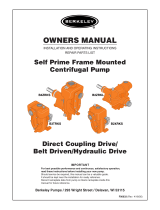
A. NO DISCHARGE
1. Pump not primed
2. Speed too low (when direct con-
nected to electric motor, deter-
mine whether or not motor is
across the line and receives full
voltage)
3. System head too high
4. Suction lift higher than that for
which pump is designed
5. Impeller completely plugged
6. Wrong direction of rotation
7. Air leak in the suction line
8. Air leak through stuffing box
B. INSUFFICIENT DISCHARGE
1. Air leaks in suction line or stuffing
box
2. Speed too low (when direct con-
nected to electric motor, deter-
mine whether or not motor is
across the line and receives full
voltage)
3. System head higher than antici-
pated
4. Insufficient NPSH (net positive
suction head). Suction lift too
high. Check with gauges. Check
also for clogged suction line or
screen.
5. Not enough suction head for hot
or volatile liquids
6. Foot valve too small
7. Impeller partially plugged
8. Mechanical defects:
Wearing rings worn
Impeller damaged
Foot valve or suction opening
not submerged enough
Wrong direction of rotation
C. INSUFFICIENT PRESSURE
1. Speed too low (when direct con-
nected to electric motor, deter-
mine whether or not motor is
across the line and receives full
voltage)
2. System head less than anticipated
3. Air or gas in liquid
4. Mechanical defects:
Wearing rings worn
Impeller damaged
Impeller diameter too small
Wrong direction of rotation
D. LOSS OF SUCTION FOLLOWING
PERIOD OF SATISFACTORY
OPERATION
1. Leaky suction line
2. Waterseal plugged
3. Suction lift too high or insufficient
NPSH
4. Air or gas in liquid
5. Casing gasket defective
6. Clogging of strainer
E. EXCESSIVE POWER
CONSUMPTION
1. Speed too high
2. System head lower than rating,
pumps too much liquid
3. Specific gravity or viscosity of
liquid is too high
4. Mechanical defects:
Shaft bent
Rotating element binds
Stuffing boxes too tight
Wearing rings worn
F. VIBRATION
1. Air leak in suction line
2. Air or gas in liquid
3. Impeller partially plugged
4. Mechanical defects:
Damaged impeller
Misalignment of pump and
driver
Bearing worn
Rotor out of balance
Shaft bent
5. Foundation not rigid
G. MOTOR RUNS HOT
1. Speed too high
2. Specific gravity or viscosity of
liquid pumped is too high
3. Mechanical defects:
Shaft bent
Rotating element binds
Defects in motor
Voltage and/or frequency
lower than rating
Misalignment of pump and
driver
H. PUMP BEARINGS OVERHEAT
1. Contaminated lubricant
2. Mechanical defects:
Shaft bent
Rotor out of balance
Misalignment of pump and
driver
Problem Analysis
Do it Once. Do it Right.
TACO, INC., 1160 Cranston Street, Cranston, RI 02920 Telephone: (401) 942-8000 FAX: (401) 942-2360.
TACO (Canada), Ltd., 6180 Ordan Drive, Mississauga, Ontario L5T 2B3. Telephone: 905/564-9422. FAX: 905/564-9436.
Visit our web site at: http://www.taco-hvac.com
Printed in USA
Copyright 2002
TACO, Inc.
Limited
Warranty
Commercial Pump Warranty Terms
(Models FI, CI, FE, CE, KV, KS, TA)
Taco, Inc. will repair or replace without charge
(at the Company’s option) any commercial pump
product or part which is proven defective under
normal use within one year from date of start-up
or one year and six months from date of shipment
(whichever occurs first).
In order to obtain service under warranty, it is
the responsibility of the purchaser to promptly
notify the Company in writing and promptly deliv-
er the item in question, delivery prepaid to the
factory. For complete details on warranty returns,
the purchaser should contact a local Taco stock-
ing distributor or the Company. If the product or
part in question contains no defect as covered in
this warranty, the purchaser will be billed for parts
and labor charges in effect at time of factory
examination or repair.
Motors provided on commercial pumps are not
covered by this warranty, and are warranted by the
motor manufacturer. For complete details on
motor warranty returns, the purchaser should con-
tact the motor manufacturer’s local service repair
center or contact the motor manufacturer directly.
Seals provided on commercial pumps are not
covered by this warranty.
Any Taco product or part not installed or oper-
ated in conformity with Taco instructions or which
has been subjected to misuse, misapplication,
the presence of certain chemicals (such as sol-
vents, acids, etc.) or other abuse will not be cov-
ered by this warranty. For complete information
on chemical and application restrictions, the pur-
chaser should contact the company.
Taco, Inc. reserves the right to make changes in
details of design, construction, or arrangement of
materials of its products without notification.
Taco, Incorporated offers this warranty in lieu of
all other express or implied warranties. No war-
ranties are made for merchantability or fitness for
use and there are no warranties which extend
beyond the description contained herein. Taco,
Inc. will not be liable for any special, incidental, or
consequential damages.







